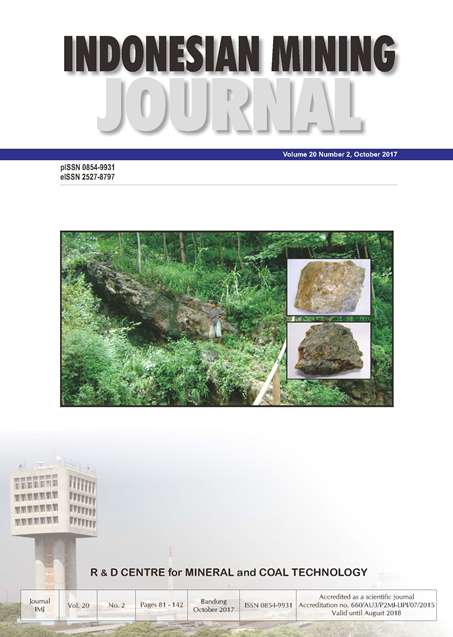BIOLEACHING OF LODAN QUARTZ USING Aspergillus ficuum
DOI:
https://doi.org/10.30556/imj.Vol20.No2.2017.283Keywords:
Aspergillus ficuum, bioleaching, citric acid, oxalic acid, quartzAbstract
Depending on its purity, quartz has a wide application in industry. Fungi play an important role in the quartz purification. A bioleaching study of Lodan quartz sample from Rembang, Central Java was conducted to obtain a suitable raw material for industrial applications. The microbial process using selected-indigenous fungus of Aspergillus ficuum in terms of removing iron, aluminum, and other unwanted metals within quartz. The result was then compared to the chemical leaching using pure citric and oxalic acids. The bioleaching process removed the iron (Fe2O3) from the initial content (0.78%) in the original sand sample to reach a level of 0.013% Almost 98.3% iron was removed. The bioleaching test also removed the aluminum, manganese, chrome, and titanium to a very low level within the 12-day process. The iron content in this treated quartz met the standards for optical and high-quality glass. On the other hand, the chemical leaching using pure citric and oxalic acids concentrations were equal to those that were produced by A. ficuum could only removed 70.5% of iron around 0.23% iron and 0,29 % aluminium were still remained in the sand. This fact suggested that the bioleaching method is more effective than the chemical one using the organic acids. The use of fungi to remove iron from quartz has the potential to be an effective method for upgrading the content and the commercial value of the quartz. The experimental results of this study have provided significant opportunity to use biotechnological approach for producing the quartz as a feed material for the high-quality glass industry.
References
Arslan, V. and Bayat, O. (2009) “Iron removal from Turkish quartz sand by chemical leaching and bioleaching,” Minerals and Metallurgical Processing, 26(1), pp. 35–40. Available at: http://mmp.smenet.org/abstract.cfm?aid=2777.
Brisson, V. L., Zhuang, W.-Q. and Alvarez-Cohen, L. (2016) “Bioleaching of rare earth elements from monazite sand,” Biotechnology and Bioengineering, 113(2), pp. 339–348. doi: 10.1002/bit.25823.
Götze, J. and Möckel, R. (eds.) (2012) Quartz: Deposits, mineralogy and analytics. Berlin, Heidelberg: Springer Berlin Heidelberg. doi: 10.1007/978-3-642-22161-3.
Gurevich, Y. L., Teremova, M. I., Bondarenko, G. N., Kislan, S. L. and Abhilash (2015) “Bio-chemical leaching of kaolinite-hematite-boehmite type bauxite sand,” Indian Journal of Chemical Technology, 22, pp. 248–252. Available at: http://hdl.handle.net/123456789/33526.
Handayani, S. and Suratman (2016) “Bioleaching of low grade nickel ore using indigenous fungi,” Indonesian Mining Journal, 19(3), pp. 143–152.
Hassanien, W. A. G., Desouky, O. A. N. and Hussein, S. S. E. (2014) “Bioleaching of some rare earth elements from Egyptian monazite using Aspergillus ficuum and Pseudomonas aeruginosa,” Walaikal Journal of Science and Technology (WJST), 11(9), pp. 809–823. doi: 10.14456/WJST.2014.85.
Haus, R., Prinz, S. and Priess, C. (2012) “Assessment of High Purity Quartz Resources,” in Quartz: Deposits, Mineralogy and Analytics. Berlin, Heidelberg: Springer Berlin Heidelberg, pp. 29–51. doi: 10.1007/978-3-642-22161-3_2.
Hernández, R. A. H., García, F. L., Cruz, L. E. H. and Luévanos, A. M. (2013) “Iron removal from a kaolinitic clay by leaching to obtain high whiteness index,” IOP Conference Series: Materials Science and Engineering, 45, p. 12002. doi: 10.1088/1757-899X/45/1/012002.
Platias, S., Vatalis, K. I. and Charalampides, G. (2014) “Suitability of quartz sands for different industrial applications,” Procedia Economics and Finance, 14, pp. 491–498. doi: 10.1016/S2212-5671(14)00738-2.
Salmimies, R., Mannila, M., Kallas, J. and Häkkinen, A. (2012) “Acidic dissolution of hematite: Kinetic and thermodynamic investigations with oxalic acid,” International Journal of Mineral Processing, 110–111, pp. 121–125. doi: 10.1016/j.minpro.2012.04.001.
Štyriaková, I., Bekényiová, A., Štyriaková, D., Jablonovská, K. and Štyriak, I. (2015) “Second pilot-plant bioleaching verification of the iron removal from quartz sands,” Procedia Earth and Planetary Science, 15, pp. 861–865. doi: 10.1016/j.proeps.2015.08.138.
Štyriaková, I., Mockovčiaková, A., Štyriak, I., Kraus, I., Uhlík, P., Madejová, J. and Orolínová, Z. (2012) “Bioleaching of clays and iron oxide coatings from quartz sands,” Applied Clay Science, 61, pp. 1–7. doi: 10.1016/j.clay.2012.02.020.
Šuba, J. and Štyriaková, D. (2015) “Iron minerals removal from different quartz sands,” Procedia Earth and Planetary Science, 15, pp. 849–854. doi: 10.1016/j.proeps.2015.08.136.
Suratman and Handayani, S. (2014) “Beneficiation of Sambiroto silica sand by chemical and biological leachings,” Indonesian Mining Journal, 17(3), pp. 134–143. Available at: https://jurnal.tekmira.esdm.go.id/index.php/imj/article/view/318.
Tuncuk, A. and Akcil, A. (2014) “Removal of iron from quartz ore using different acids: A laboratory-scale reactor study,” Mineral Processing and Extractive Metallurgy Review, 35(4), pp. 217–228. doi: 10.1080/08827508.2013.825614.
Vapur, H., Top, S. and Demirci, S. (2017) “Purification of feldspar from colored impurities using organic acids,” Physicochemical Problems of Mineral Processing, 53(1), pp. 150–160. doi: 10.5277/ppmp170112.
Xakalashe, B. S. and Tangstad, M. (2011) “Silicon processing: from quartz to crystalline silicon solar cells,” in Southern African Pyrometallurgy 2011 International Conference. Johannesburg: The Southern African Institute of Mining and Metallurgy, pp. 83–99.
Zhang, Z., Li, J., Li, X., Huang, H., Zhou, L. and Xiong, T. (2012) “High efficiency iron removal from quartz sand using phosphoric acid,” International Journal of Mineral Processing, 114–117, pp. 30–34. doi: 10.1016/j.minpro.2012.09.001.
Downloads
Published
Issue
Section
License
Indonesian Mining Journal provides immediate open access to its content on the principle that making research freely available to the public to supports a greater global exchange of knowledge.

This work is licensed under a Creative Commons Attribution-NonCommercial 4.0 International License.













